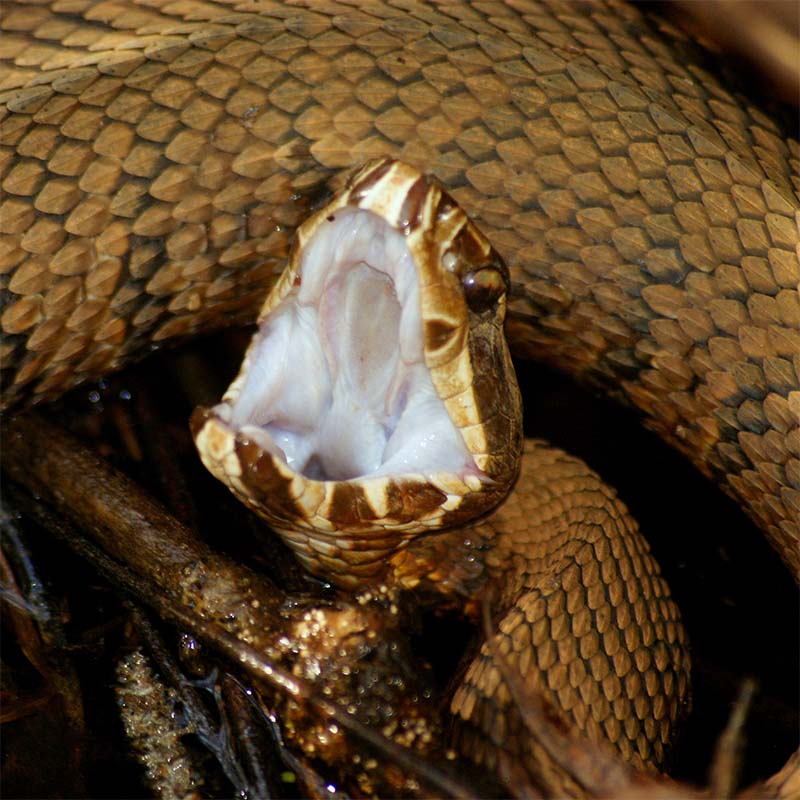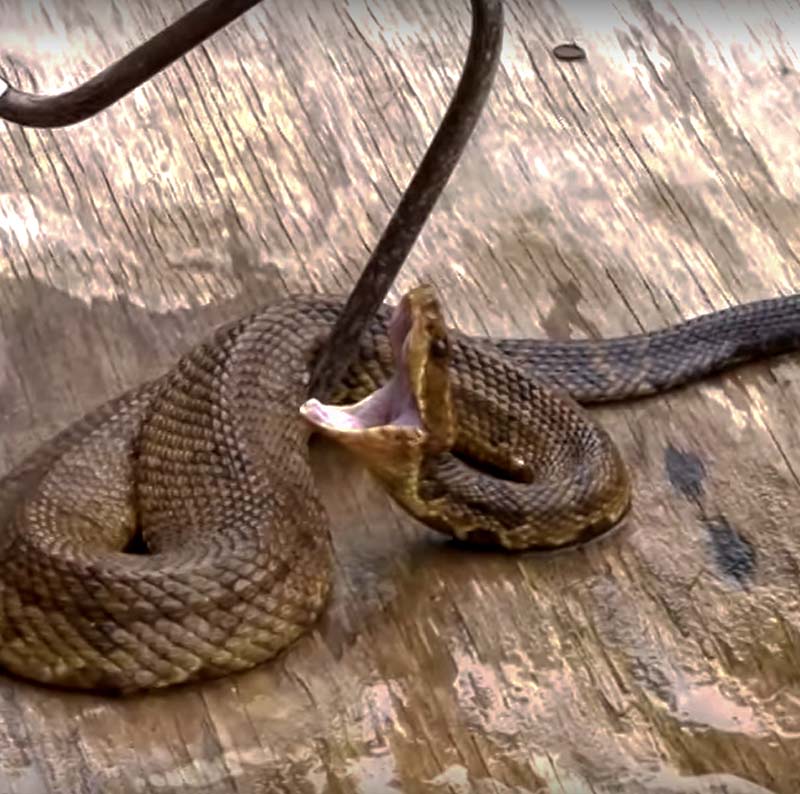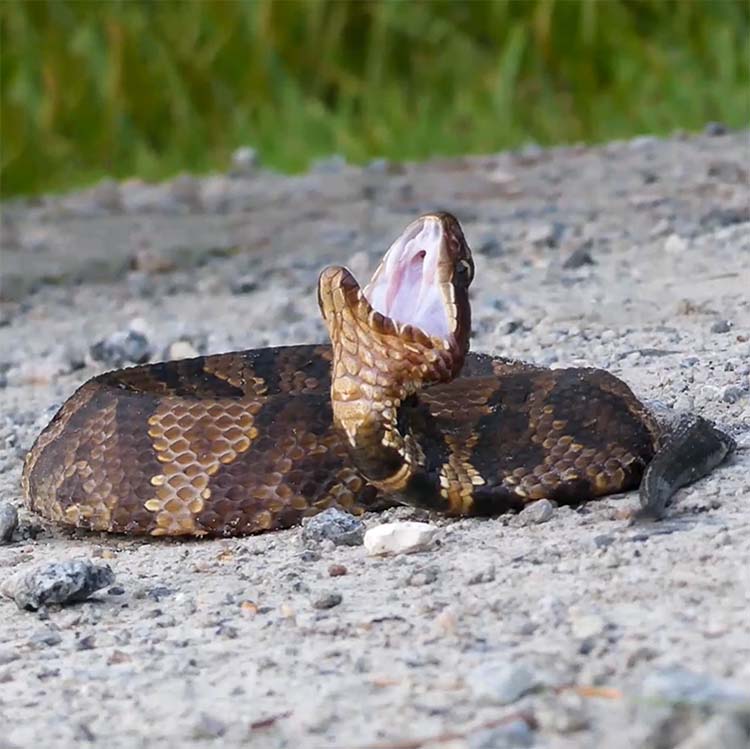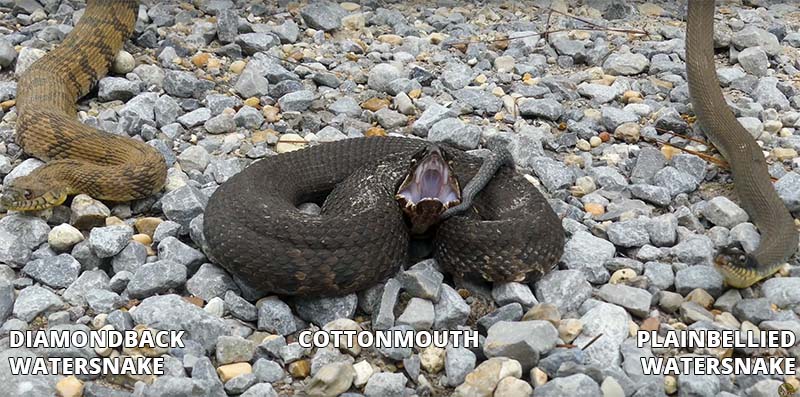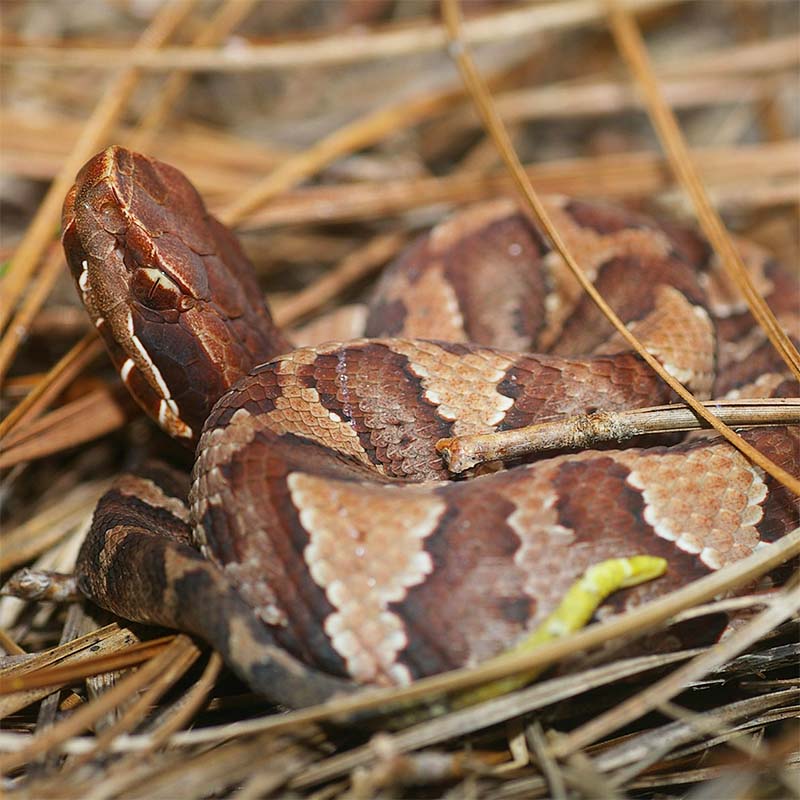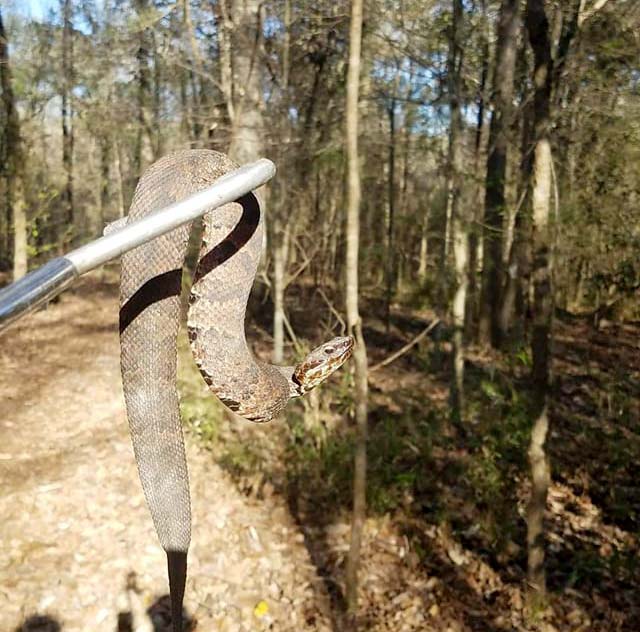
- Scientific Name
- Agkistrodon piscivorus
- Range
- Southeast Virginia
- Also Known As
- Water Moccasin, Black Snake, Highland Moccasin
- Prey
- Birds, Fish, Mammals, and Snakes
- Venomous
- Yes
- Features
- Dark/Olive Color with Hourglass Bands
- Litter Size
- 10 to 20 per Birth
- Life Span
- 10 Years
- Length
- 2.5 - 4 Feet
Quick Links
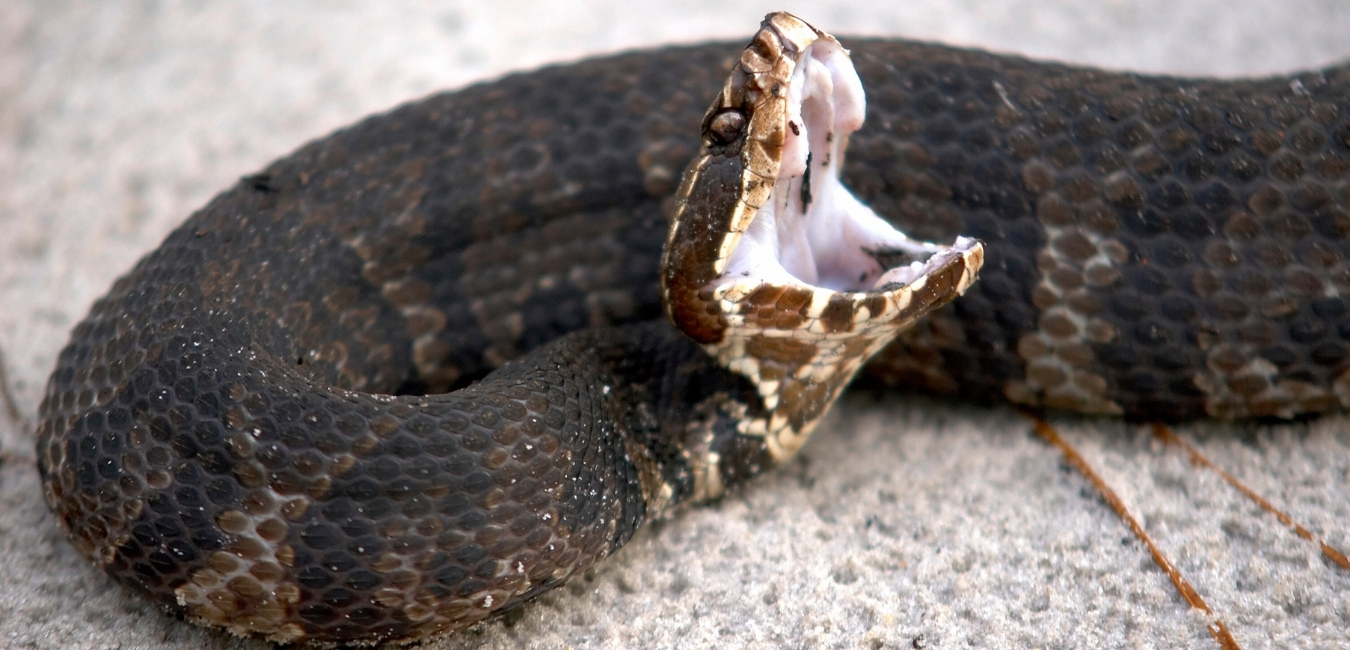
Brief Introduction to the Cottonmouth
Also known as the water moccasin, the cottonmouth snake is a master ambush predator of southeastern Virginia’s wetlands and waterways. This guide covers identifying cottonmouths by appearance, range and habitat preferences, hunting and feeding behaviors, reproduction and growth, venom risks and bite treatment, and proper safety precautions.
We will overview key cottonmouth facts including their variable coloring, defensive postures like neck flattening, activity cycles, opportunistic diet, reproductive mating rituals, potent venom effects, and common myths. Detailed sections are dedicated to differentiating cottonmouths from lookalike species, appropriate responses if bitten, and professional snake removal services. Photos, maps, and diagrams illustrate key cottonmouth identification traits, habitats, and behaviors
Cottonmouth/Water Moccasin Description
The cottonmouth snake, also known as the water moccasin, shows drastic changes in appearance from birth to adulthood.
But one constant is the white, cotton-like interior of their mouth, which gives the species its name.
Juveniles
Newly born cottonmouths exhibit vibrant yellow-brown bands and measure up to 33 cm in total length. An electric yellow tail tip mimics caterpillars, luring fish and frogs within striking range.
Juvenile patterning camouflages smaller cottonmouths in shoreline debris. As tail tips fade from yellow to black, banding disappears into scale-covered skin.
Adults
Once cottonmouths reach maturity after 2-3 years, thick black or brown skin replaces thin juvenile patterning. Adults develop stocky bodies over 61 cm long, with dark pigment obscuring any trace of bands.
Their ominous coloration mimics rotting swamp vegetation, blending into southeastern wetlands. Difficult to spot, adult cottonmouths surprise prey with sudden attacks.
Size
Adult cottonmouths average 4-5 feet (122-152 cm) in length, with females growing larger than males. Newborns measure 8-13 inches (20-33 cm) and rapid growth occurs in the first year.
Myth: Cottonmouths and Water Moccasins Will Chase You
False:
Cottonmouths are actually very slow when on land, and the cottonmouth will not risk injury to fight a large animal like a human. Cottonmouths prefer for ambush in the water and very rarely bite humans even when stepped on. Odds are if the cottonmouth is heading in your direction, then it is most likely trying to head to safety and you just happen to be in it’s path. But treat this snake with caution as it is indeed venomous, and while the odds are low, a bite can still happen.
Identifying a Cottonmouth and Water Moccasin
Cottonmouths tend to get confused with harmless snakes a lot here in Virginia. Are you unsure if you have a Cottonmouth on your property? Follow this guide, so you won’t get confused!
Pattern
Just like their cousins the copperhead, cottonmouths have hourglass bands on their backs. This means that the patterns will get thinner near their spine, and wider on the sides leading to the belly.
It is important to note, that the older a cottonmouth is the more solid the coloration they get. That means that the pattern will get harder if not impossible to see the older the snake is. However, with juveniles, they have a sulfur color on the tip of their tail.
If you see a snake with a sulfur color on the tip of their tail avoid it! It could either be a Copperhead or a Water Moccasin.
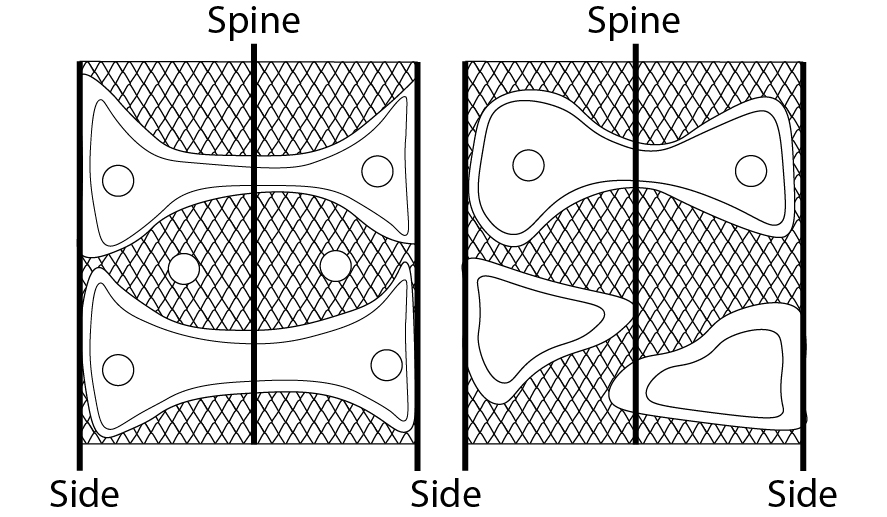
Colors
What sets Cottonmouths apart from Copperheads is their darker color. Cottonmouths tend to be a dark green/Olive color to almost black coloration. Their bands also tend to be dark brown or black as well.
But the easiest way to identify is the color of the inside of their mouths. Cottonmouths, have a white cotton color to the inside of their mouths, as their name states. Cottonmouths will show their mouths when threatened. So if any snake displays this behavior and has a white mouth stay away!
Head Shape
Here in Virginia, head shape can help distinguish cottonmouths from nonvenomous lookalikes. Cottonmouths have wide, triangular-shaped heads with distinctive jowls housing their venom glands. This triangular head is a key indicator of venom, unlike rounded heads of harmless water snakes.
However, when threatened, cottonmouths may flatten their necks to appear even more triangular. And some nonvenomous snakes like hognose snakes flatten their heads to imitate the triangular shape as self-defense.
So while head shape can aid identification, look for other markings and behavior clues to conclusively identify cottonmouths in Virginia.
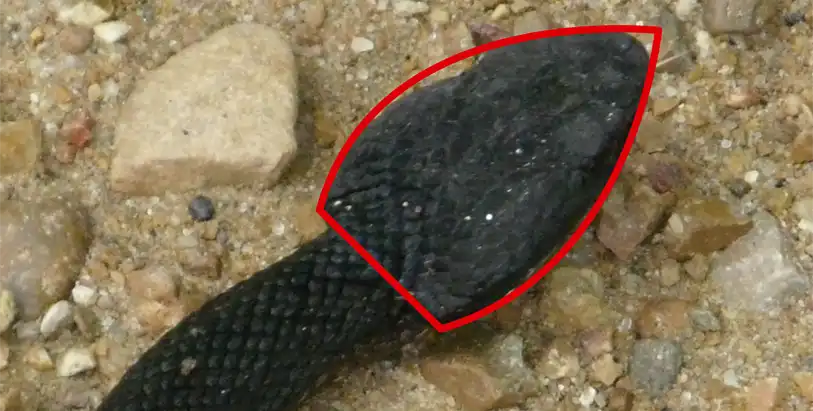
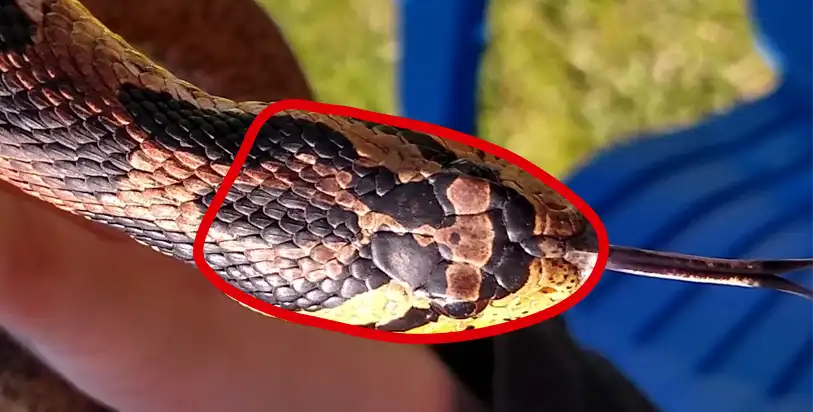
Cottonmouth Behavior
The cottonmouth exhibits behaviors allowing it to thrive across its southeastern wetland habitats in Virginia. Crepuscular by nature, its activity peaks during dim hours of dawn and dusk. An opportunistic feeder, it employs patience and persistence to consume prey both in water and on land.
While generally calm, the cottonmouth turns aggressive when threatened, flattening its neck and showing the white interior of its mouth as warnings. Despite its bite being potentially deadly, the cottonmouth is not inherently aggressive toward humans.
Activity Cycles
Cottonmouths can hunt day or night, but peak activity occurs in the dimmer hours around sunrise and sunset. They bask in sunny areas midday.
During hot summer months, they become more nocturnal to avoid overheating while foraging.
As temperatures cool, they readily venture out during daylight. Cottonmouths mate in early summer, fight over females, then brumate over winter before re-emerging in spring.
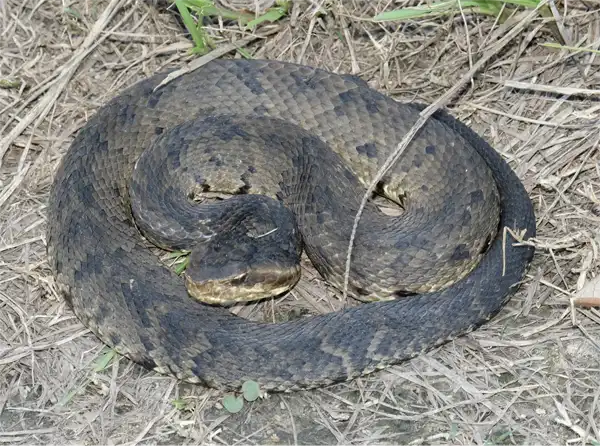
Defensive Behaviors
When approached by threats, cottonmouths often stand their ground.
They may flatten their neck into a triangular shape, coil up, vibrate their tail, release a foul-smelling musk, hiss loudly, and open their mouth wide to display the white interior as warnings before striking.
This elaborate sequence of defensive postures makes the snake seem bigger and more dangerous to ward off predators.
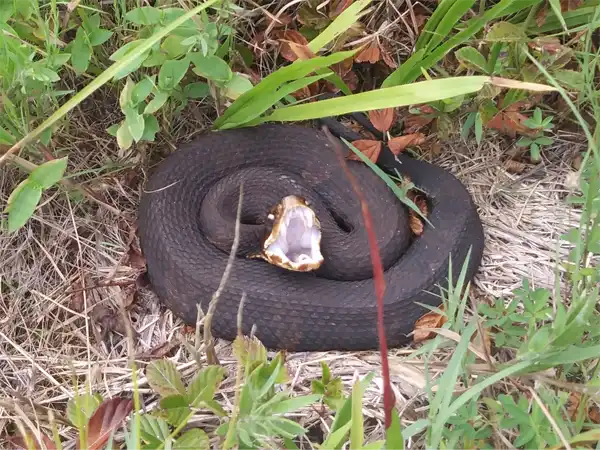
Bites
Cottonmouths use biting as a last resort for defense.
Bites often occur when humans accidentally touch or attempt to handle them. The venom can be deadly without proper medical treatment.
In Virginia, cottonmouth bites most often occur near freshwater in summer when human recreation increases. Prompt hospital treatment minimizes health risks if bitten.

Habits
Cottonmouths are strong swimmers and climb well when young, allowing exploitation of both aquatic and arboreal habitats early in life.
As heavy-bodied adults, they tend to stay terrestrially near cypress swamps, marshy waters, and damp woodlands.
During droughts, they gather together around shrinking water pools to find trapped prey. They may share winter hibernation burrows with other snake species when sheltering underground.
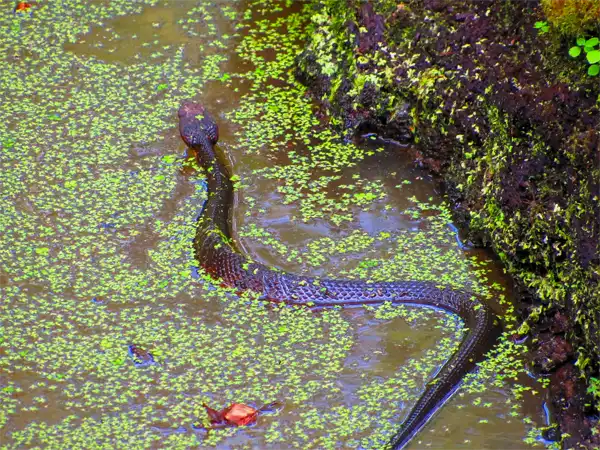
Cottonmouth and Water Moccasin Range and Habitat
Cottonmouth and Water Moccasin Range
Cottonmouths can be found in Southeastern Virginia. Cottonmouth Snakes as a whole can be found across the Southern United States.
They can be found from East Texas to Southeastern Virginia. There are two species of cottonmouth which are found in the south.
The Northern Cottonmouth and the Florida Cottonmouth as it name states is found in Florida.
Habitat
They move between wet and dry land areas as needed to control their body heat and find food sources. Cottonmouths travel over land for up to several miles if the habitat allows it.
Building homes and businesses in southeast Virginia has removed some living areas for cottonmouths. Protecting corridors between wetlands is important so populations can move and breed.
When wetlands temporarily dry up, cottonmouths gather in shallow pools full of trapped fish and frogs to eat.
Diet
Cottonmouths or Water Moccasins are known as opportunistic feeders. This means that if they see an opportunity to catch and eat prey, they will not hesitate to strike. They do not care about what the prey is, as long as it doesn’t give them too much trouble.
Cottonmouths eat both land and water animals including amphibians, lizards, snakes (this includes other cottonmouths), turtles, baby alligators, birds, and mammals, but their favorite to eat is fish.
Myth: Cottonmouths Cannot Bite Underwater
False:
Cottonmouth Snakes Reproduction and Young
Reproduction
Cottonmouth Snakes mate from April – May. Cottonmouths have a ritual where the males wave their tails and move around like a dance to lure potential mates. Fights between males are common during the mating dance.
Eggs and Young
Cottonmouths give birth in the late summer or in the fall usually from 10 to 20 babies. They do not lay eggs, so if you find any eggs on your property be at ease that they are not Water Moccasins. This is because they are ovoviviparous which means that the eggs are hatched in the body of the mother. Young Cottonmouth Snakes have yellow tips on their tails. These are used to mimic caterpillars to attract fish and other aquatic prey, until they get large enough to hunt larger prey.
When born Water Moccasins will leave and strike out on their own.
Cottonmouth Venom and Danger
Venom Effects of Water Mocassin
Cottonmouth venom rarely leads to death however you must go to the hospital immediately if bit. A Cottonmouth bite can lead to an allergic reaction and infection, which will lead to death or amputation.
Cottonmouth venom will lead to these symptoms:
- Rapid redness/Swelling around the bite
- Extreme Debilitating Pain
- Increased Heart rate
- Getting hard to breathe
- Numbness or tingling around the mouth, tongue, scalp, feet, or the bite area.
- Increase of Salivation and Perspiration
- Numbness of limbs and face
- Having signs of Shock
- Passing out (losing consciousness).
- Feeling very dizzy or lightheaded, like you may pass out.
- Slow thinking and not being alert. You may be confused, restless, fearful, or unable to respond to questions.
- Feeling weak or having trouble standing
If You Have Been Bitten by a Cottonmouth Snake
- Stay Calm an increased heart-rate will pump your blood faster which will make the venom spread throughout the body faster.
- Take a Photo or Video of the Snake this will lead dispatch to know what snake has bit you which will help get the right antivenin to you. If you can’t write down or make a note of the size, color, and patterns of the snake
- Dial 911. Do Not Drive Yourself to the Hospital Dizziness and passing out is a very common symptom from snake bites.
- Lay or Sit down. Be Comfortable
- Keep Bite Below Heart This will make the venom fight gravity to reach your heart.
- Remove Rings and Watches The swelling from the bite can cause swelling, which can lead to circulatory issues from watches and rings
Myth: Cutting and Sucking Out the Venom Helps Snake Bites
False:
Sucking the venom out of a bite is a futile effort, as by the time that you get to it a lot of the venom would be already spread out. Plus cutting and sucking will lead to an infection, which will make it more likely for the bite to be fatal.
